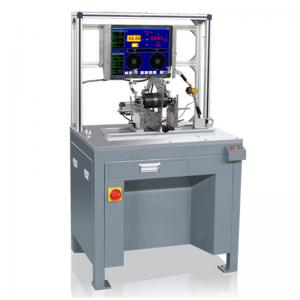Structure and Function Overview of Dynamic Balancing Machine

The structure of a dynamic balancing machine is divided into three parts: mechanical, electrical measurement, and electrical control
1. Mechanical part: The mechanical part is also known as the mechanical bridge. Taking a horizontal dynamic balancing machine as an example, the lower bed of the balancing machine mainly holds the various components and stabilizing equipment of the balancing machine. It can be said that the lower part is a foundation, and the rotor is supported by two swing frames on the left and right through rollers or V-shaped frames, providing the prerequisite for the working rotation of the rotor. The rotation of the rotor is driven by a belt or coupling, and the sensor Jiang Zhendong, installed on two swing frames, converts the new signal into an electrical signal and transmits it to the electrical measurement part to coordinate the work.
2. Electrical measurement part: Electrical measurement, also known as electrical measurement system, mainly processes the electrical signals transmitted by sensors and displays the position and size of the rotor unbalance. Coordinate the work of the mechanical part. At the same time, the electrical measurement part is also a key component in the balancing machine, and the quality of this part can be said to directly affect the performance of the balancing machine.
3. Electronic control part: The main function is to control the start and stop of dragging and clicking, and adjust the speed in a timely manner, also known as the electronic control box. The electronic control part can be divided into DC and AC control, and some balance machines have an integrated electronic control part and mechanical part.

The structure of a dynamic balancing machine is divided into three parts: mechanical, electrical measurement, and electrical control
1. Mechanical part: The mechanical part is also known as the mechanical bridge. Taking a horizontal dynamic balancing machine as an example, the lower bed of the balancing machine mainly holds the various components and stabilizing equipment of the balancing machine. It can be said that the lower part is a foundation, and the rotor is supported by two swing frames on the left and right through rollers or V-shaped frames, providing the prerequisite for the working rotation of the rotor. The rotation of the rotor is driven by a belt or coupling, and the sensor Jiang Zhendong, installed on two swing frames, converts the new signal into an electrical signal and transmits it to the electrical measurement part to coordinate the work.
2. Electrical measurement part: Electrical measurement, also known as electrical measurement system, mainly processes the electrical signals transmitted by sensors and displays the position and size of the rotor unbalance. Coordinate the work of the mechanical part. At the same time, the electrical measurement part is also a key component in the balancing machine, and the quality of this part can be said to directly affect the performance of the balancing machine.
3. Electronic control part: The main function is to control the start and stop of dragging and clicking, and adjust the speed in a timely manner, also known as the electronic control box. The electronic control part can be divided into DC and AC control, and some balance machines have an integrated electronic control part and mechanical part.
124 browse
